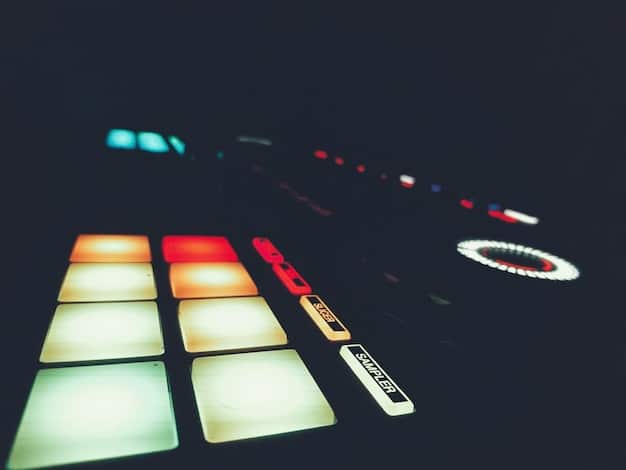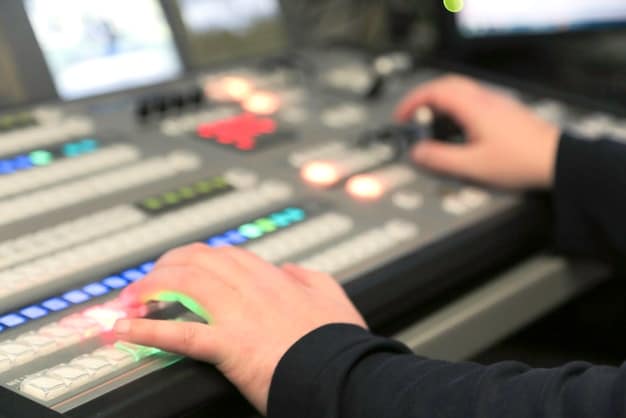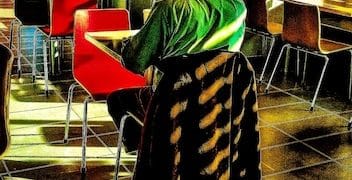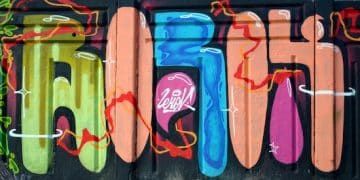Copyright Laws 2025: Impact on Hip Hop Sampling

New copyright legislation set for 2025 is reshaping the landscape of music sampling, directly influencing artistic freedom and economic models within Hip Hop, mandating clearer licensing agreements and potentially altering the genre’s foundational creative processes.
The evolution of Hip Hop is inextricably linked to the art of sampling, a creative cornerstone that has defined its sound and innovation for decades. As we approach 2025, a critical question emerges: How Will New Copyright Laws Impact Sampling in Hip Hop in 2025? This isn’t merely a legal inquiry; it’s a conversation about the future of artistic expression, economic viability, and the very essence of a genre built on homage and reinvention. Understanding these shifts is crucial for producers, artists, and fans alike, as the legal framework evolves to address modern creative practices.
the shifting sands of copyright law
Copyright law is a living entity, constantly adapting to new technologies and artistic forms. For Hip Hop, the practice of sampling — taking a portion of one sound recording and reusing it in another — has always operated in a complex legal grey area. Early Hip Hop often saw samples used without proper clearance, largely due to the nascent state of copyright enforcement in digital music. Over the years, landmark cases have shaped how rights holders and artists interact regarding sampled material.
The legal framework aims to protect the intellectual property of creators while also fostering new artistic works. This balance is delicate, particularly when the creative process inherently involves recontextualizing existing art. New legislation tends to clarify ambiguities and address omissions from previous laws, often spurred by technological advancements or industry shifts.
historic legal precedents and their lessons
A few pivotal cases have significantly influenced the legal treatment of sampling. For instance, the Grand Upright Music, Ltd. v. Warner Bros. Records Inc. case in 1991, involving Biz Markie’s “Alone Again,” set a precedent that “sampling is stealing.” This ruling sent shockwaves through the industry, emphasizing the need for clearances and fair compensation.
- Bridgeport Music, Inc. v. Dimension Films (2005): This case established a strict rule in the Sixth Circuit, stating “get a license or do not sample.” It removed any de minimis exception for sound recordings, meaning even tiny, unrecognizable samples could require clearance.
- Pharrell Williams & Robin Thicke v. Marvin Gaye’s Estate (2015): Though not directly a sampling case, the “Blurred Lines” verdict highlighted the importance of protecting the “feel” or “groove” of a song, creating broader implications for derivative works and potential claims of infringement based on stylistic similarity.
These cases have collectively nudged the industry towards more stringent clearance practices, pushing artists and labels to navigate a complex web of permissions and royalties. The upcoming 2025 laws are expected to build upon these foundations, potentially introducing new mechanisms for licensing or modifying existing definitions of what constitutes a “fair use” of sampled material, especially considering the rise of AI-generated content and blockchain applications in music.
expected changes in copyright legislation for 2025
As we approach 2025, legislative bodies and industry stakeholders are pushing for new copyright frameworks that address the realities of modern music creation and consumption. The digital age has blurred lines, making it easier than ever to create, distribute, and sample music. The new laws are anticipated to formalize some existing practices and introduce novel mechanisms to streamline the process of intellectual property management.
One major area of focus for legislators is the clarification of “fair use” as it applies to sampling. While fair use generally allows for the limited use of copyrighted material without permission for purposes such as criticism, comment, news reporting, teaching, scholarship, or research, its application to musical sampling has been contentious. The upcoming laws might provide clearer guidelines on what constitutes transformative use versus direct infringement, which could significantly impact the creative scope for Hip Hop artists.
potential introduction of blanket licensing or micro-licensing schemes
To mitigate the complexities and high costs associated with clearing individual samples, some proposals suggest the implementation of new licensing frameworks. These could include:
- Blanket Licensing: A system where a single license would cover the use of numerous copyrighted works from a broad catalog, similar to how performing rights organizations (PROs) operate for public performances. This could greatly simplify the process for Hip Hop producers.
- Micro-Licensing: A more granular approach, possibly facilitated by blockchain technology, where small, direct transactions could occur for very specific, short samples. This would allow for more flexible and potentially less expensive clearance for minor uses.
Such schemes, if adopted, would represent a monumental shift. They could empower smaller artists and independent labels to legally incorporate samples without prohibitive financial barriers. However, the challenge lies in designing a system that is fair to both rights holders (ensuring proper compensation) and samplers (enabling creative freedom and affordability). The details concerning royalty distribution and catalog management under such systems are still subject to intense debate among industry giants and artist advocacy groups.
Another significant aspect expected in 2025’s copyright overhaul is increased accountability for distribution platforms. Streaming services and digital music stores might be compelled to implement more robust content identification technologies and stricter enforcement protocols for uncleared samples. This could mean increased scrutiny at the point of upload, potentially leading to immediate takedowns or revenue withholding for tracks that have not sufficiently cleared their sampled material. Consequently, artists may experience a more streamlined, albeit potentially stricter, environment for sample usage. These forthcoming changes aim to create a more transparent and equitable ecosystem for all participants in the music industry, from the original creators to the artists who build upon their foundations.
impact on hip hop artists and producers
For Hip Hop artists and producers, sampling is more than just a technique; it’s a fundamental element of their creative expression. The genre flourished by repurposing sounds, creating new narratives and textures from existing musical fragments. The changes in copyright law expected in 2025 will inevitably reshape this creative process, presenting both challenges and opportunities that artists will need to navigate.
The most immediate challenge is the potential for increased legal scrutiny and higher costs associated with sample clearance. If the laws become stricter or if enforcement mechanisms are enhanced, artists might find it more difficult or expensive to use samples. This could push them towards alternative creative methods, such as original compositions or the use of royalty-free sample packs, which don’t carry the same legal liabilities. The economic disparity among artists means that established acts with significant legal budgets might weather these changes more easily than independent or emerging artists, potentially stifling grassroots innovation if access to samples becomes prohibitively expensive.

the shift towards original compositions and interpolation
Faced with stricter sampling laws, Hip Hop producers may increasingly turn to original compositions to build their beats. This could foster a new wave of musical creativity within the genre, where artists are challenged to craft sounds from scratch, developing unique melodies and drum patterns without relying on existing recordings. This shift could lead to a sound that is less reliant on recognizable samples and more focused on original instrumentation and arrangement.
- Interpolation: This technique involves re-recording an existing melody or lyric rather than directly sampling the original recording. While still subject to copyright for the underlying musical composition or lyrics, it bypasses the need for a sound recording license, which is often the more expensive and complex part of sample clearance.
- Creative Sound Design: Artists might invest more time in creating their own unique sounds through synthesizers, acoustic instruments, or field recordings. This approach minimizes copyright issues entirely, allowing for complete creative control and originality.
Furthermore, heightened legal requirements could lead to a more collaborative environment between artists and rights holders, or between artists and lawyers specializing in music law. Artists might invest earlier in legal counsel to pre-clear potential samples or to understand the nuances of the new laws. This proactive approach could prevent costly litigation down the line but also adds another layer of complexity to the creative workflow. The Hip Hop community, known for its adaptability and innovativeness, will undoubtedly find new ways to express itself within these evolving legal boundaries, whether through new forms of creation or by challenging the very nature of these laws in the courts of appeal and public opinion.
implications for independent artists and labels
The impact of new copyright laws on Hip Hop’s independent sector warrants particular attention. Independent artists and labels often operate with limited resources, making the already complex and expensive process of sample clearance a significant barrier. As copyright laws evolve in 2025, these entities face unique challenges that could reshape their creative and business models.
One of the primary concerns for independent artists is the financial burden. Clearing a single sample can involve negotiations with multiple rights holders—the owner of the sound recording AND the owner of the musical composition—each demanding a share of royalties or an upfront fee. For a large catalog of sampled material, these costs can quickly become prohibitive, forcing independent creators to either abandon projects or risk legal repercussions. The potential for more stringent enforcement under the new laws means that the stakes for non-compliance will be even higher.
navigating legal complexities with limited resources
Independent artists often lack dedicated legal teams that major labels employ. This disparity makes navigating the intricate landscape of copyright law a daunting task. The new laws could introduce more formal requirements for digital platforms or more aggressive policing of unlicensed material, which would disproportionately affect artists without robust legal support.
- Increased Reliance on Legal Tech Solutions: Digital tools and platforms designed to simplify copyright clearances or track usage might become essential for independent acts. However, access to these tools could still pose economic barriers.
- Community-Driven Legal Aid: We might see the rise of more community-based initiatives or non-profits offering legal guidance for independent musicians, helping them understand and comply with complex copyright regulations.
Despite these challenges, the new landscape could also spur innovation within the independent scene. Artists might explore sampling techniques that are less legally fraught, such as using public domain material, creating their own sample libraries, or developing entirely original sounds. Some independent labels may also seek to create innovative licensing deals directly with smaller, independent rights holders, fostering a more collaborative and less adversarial environment for sample usage. The independent Hip Hop community has historically thrived on resourcefulness and ingenuity; therefore, while the new laws present hurdles, they also ignite the creative spirit to find innovative paths to artistic expression and economic sustainability within the genre’s ever-evolving legal framework.
the role of technology in future copyright enforcement
As copyright laws adapt, so too does the technology used to enforce them. The year 2025 is anticipated to bring significant advancements in how copyrighted material, especially samples, is identified, tracked, and licensed across digital platforms. These technological shifts are not merely tools; they are becoming integral to the enforcement ecosystem, influencing how music is created, distributed, and monetized.
One of the most prominent technological advancements relevant to copyright is improved audio fingerprinting and content recognition software. Platforms like YouTube’s Content ID already demonstrate the ability to identify copyrighted audio within uploaded content. New legal frameworks might mandate wider adoption of such technologies across all distribution channels, including smaller streaming services and social media platforms. This means that uncleared samples could be flagged almost immediately upon upload, leading to automatic takedowns, demonetization, or direct negotiations for licensing.
blockchain and NFTs: a new era for intellectual property management?
Blockchain technology, known for its decentralized and immutable ledger, holds significant promise for managing intellectual property rights in music. Non-fungible tokens (NFTs), as unique digital assets on a blockchain, are already being explored for music ownership and royalty distribution. In the context of sampling, blockchain could offer:
- Transparent Ownership Records: A clear, publicly verifiable record of who owns which sound recording and musical composition, simplifying the process of identifying rights holders for sample clearance.
- Automated Royalty Distribution: Smart contracts on a blockchain could automate the payment of royalties to original creators whenever their sampled material is used, ensuring fair and timely compensation.
- Micro-Licensing Marketplace: Blockchain could support a marketplace for micro-licensing, allowing artists to license very specific fragments of their music for a small fee, making sampling more accessible and legal.
While still in their early stages, these technologies could revolutionize how permissions are granted and how creators are compensated. They could provide a level of transparency and efficiency previously unimaginable, potentially mitigating some of the legal complexities that currently plague sampling. However, the adoption of blockchain and NFTs on a widespread scale faces challenges, including scalability, energy consumption concerns, and the need for industry-wide standardization. Ultimately, the integration of advanced technologies with new copyright laws in 2025 is set to create a more sophisticated and, ideally, more equitable environment for intellectual property in the digital music domain. However, the balance between innovation, enforcement, and artistic freedom will remain a key debate as these systems mature and are implemented across the music industry.
balancing protection and creativity
The core dilemma in copyright law, especially concerning dynamic genres like Hip Hop, is striking a balance between protecting the rights of original creators and fostering an environment conducive to new artistic expression. As new copyright laws come into effect in 2025, this balance will be under increased scrutiny. The goal for policymakers is to craft legislation that prevents outright exploitation of intellectual property while not stifling the very creative processes that define a genre.
If copyright laws become overly restrictive or the cost of compliance becomes prohibitively high, there is a risk that Hip Hop, as we know it, could fundamentally change. The free flow of ideas and the ability to recontextualize sounds are central to its ethos. An overly litigious environment could push artists towards safer, less innovative avenues, potentially leading to a homogenization of sound as artists shy away from controversial or expensive samples. This would be a detriment not only to Hip Hop but to the broader musical landscape that thrives on innovation and artistic cross-pollination.
the potential for a chilling effect on artistic innovation
A “chilling effect” occurs when artists, fearing legal repercussions, self-censor their creative choices. If the legal landscape for sampling becomes too precarious, artists might avoid using samples altogether, even when their use could be considered transformative or fair. This could:
- Reduce Musical Diversity: Limit the sonic palette available to producers, potentially leading to a more uniform sound across the genre.
- Stifle Emerging Talent: Disproportionately affect independent and emerging artists who lack the resources to navigate complex legal frameworks, thus hindering their entry into the mainstream.
Conversely, robust protection for original works ensures that creators are compensated for their efforts, incentivizing continued artistic output. Without this protection, there is little incentive to create original material if it can be freely appropriated without attribution or payment. The challenge for 2025’s copyright laws is to create a system where legal compliance is clear and accessible, and where compensation flows equitably to all rights holders, without inadvertently diminishing the vibrant and evolving nature of Hip Hop. The conversation surrounding these laws must involve not just legal experts and industry executives, but also the artists and producers whose creative lives are directly impacted, ensuring that the spirit of creation remains paramount. The ongoing dialogue will be crucial to shaping a legal framework that supports both innovation and fair compensation within the ever-evolving music industry.
future outlook and recommendations for artists
Looking ahead to 2025, the future of sampling in Hip Hop appears to be at a critical juncture. While new copyright laws present challenges, they also compel artists and the industry to innovate and adapt. The landscape will likely be characterized by increased legal formality, a greater reliance on technology for clearance and enforcement, and a continued push for more equitable compensation models for creators.
For Hip Hop artists and producers, adaptability will be key. Understanding the evolving legal framework is no longer just a legal team’s job; it’s becoming an essential part of the creative process. Building a strong foundation of knowledge regarding copyright, licensing, and fair use will be crucial for navigating these changes successfully. Furthermore, embracing new technologies and creative approaches can open up new avenues for artistic expression while mitigating legal risks.
strategies for navigating the new legal landscape
To thrive in the evolving environment, artists should consider several proactive strategies:
- Educate Yourself: Stay informed about the specific details of the new copyright laws as they are enacted. Resources from artist advocacy groups, legal firms specializing in music, and industry associations can provide invaluable guidance.
- Prioritize Originality: While sampling remains a cornerstone, developing skills in original composition, instrumentation, and vocal performance can reduce reliance on uncleared samples. This fosters unique artistic identities.
- Explore Legal Sample Libraries: Utilize royalty-free or pre-cleared sample libraries, which offer a vast array of sounds without the legal complexities of traditional sampling. Many high-quality sounds are available through these channels.
- Understand Interpolation: When using existing melodies or lyrics, consider re-recording them (interpolation) rather than directly sampling. While still subject to composition copyright, this avoids the sound recording copyright, often simplifying clearance.
- Seek Professional Legal Counsel: For significant projects or when in doubt, invest in legal advice. A music lawyer can help navigate clearances, negotiate licenses, and protect your intellectual property.
- Advocate for Change: Engage with artist advocacy organizations that lobby for copyright reforms balancing creator rights with fair use and creative freedom. Your voice can contribute to shaping future legislation.
The transformation of copyright laws in 2025 is not an endpoint but a continuation of the ongoing dialogue between law, technology, and art. Hip Hop, historically a genre of resilience and innovation, will undoubtedly evolve to meet these new challenges. By being informed, creative, and proactive, artists and producers can continue to push the boundaries of music while operating within a more structured legal environment, ensuring the genre’s longevity and continued influence on global culture.
case studies: historical precedents and future implications
Understanding how past legal battles have shaped the landscape of sampling provides crucial insights into what 2025 might bring. These case studies highlight the complexities of copyright law in music and underscore the varying interpretations of “fair use” and “transformative use” within the legal system. Examining these precedents helps to predict how the new laws might be applied and how artists might need to adapt their strategies.
One of the foundational cases is the aforementioned Grand Upright Music, Ltd. v. Warner Bros. Records Inc. (1991), which involved Biz Markie’s “Alone Again.” This ruling famously declared, “Thou shalt not steal,” directly addressing unauthorized sampling. Its aftermath led to a significant shift in industry practice, making sample clearance a mandatory part of music production for major labels. This case established a precedent that unauthorized sampling, regardless of length, could be considered infringement, signaling a stricter era for Hip Hop.
the ongoing debate of transformation vs. appropriation
The argument often revolves around whether a sampled work is “transformative” (creating something new and distinct) or merely “appropriative” (taking something without sufficiently changing its character). Courts have struggled with this distinction in music, particularly when a direct sound recording is used.
- Cariou v. Prince (2013): While a visual art case, this significantly influenced the understanding of transformative use, suggesting that a work could be transformative even if it retained recognizable elements of the original, as long as it had a new meaning or message. This interpretation offers hope for sampled music, yet its direct application to audio fragments remains a contested area in music law.
- Bridgeport Music, Inc. v. Dimension Films (2005): This case set a very strict standard for sound recording samples, declaring that even a de minimis use (a very small, insignificant amount) was actionable. This “zero-tolerance” approach for sound recordings has been a major point of contention for Hip Hop artists, suggesting that even a single note could require clearance.
As we look to 2025, these historical perspectives suggest that new copyright laws may attempt to codify or refine the concept of transformative use for audio samples. There could be attempts to reintroduce a de minimis exception or establish clearer guidelines for what constitutes a permissible recontextualization versus a direct copy. The legislative challenge lies in creating a nuanced framework that acknowledges the unique creative process of sampling while providing adequate protection to original sound recordings and musical compositions. The ongoing dialogue between artists, legal scholars, and industry stakeholders will undoubtedly continue to shape how these cases are interpreted and how future legal battles play out, continually redefining the boundaries of artistic freedom versus intellectual property rights within the vibrant landscape of Hip Hop.
| Key Point | Brief Description |
|---|---|
| ⚖️ Stricter Clearance | New laws may increase the legal and financial burden for sample licensing. |
| 💡 Creative Evolution | Artists might shift towards more original compositions or interpolation techniques. |
| 🔗 Tech Integration | Better audio fingerprinting and blockchain could revolutionize IP management. |
| 📉 Independent Risks | Independent artists and labels face disproportionate challenges without robust legal support. |
frequently asked questions
▼
No, new copyright laws are unlikely to make sampling entirely illegal. Instead, they will likely tighten regulations, making it more complex and costly to obtain proper licenses. The emphasis will be on formalizing the clearance process to ensure original creators are compensated fairly, pushing artists towards clearer compliance or alternative creative methods.
▼
“Fair use” allows limited use of copyrighted material without permission for purposes like criticism or parody. However, its application to music sampling is contentious. Courts often look at whether the new work is transformative, meaning it has a distinct new meaning or purpose. New laws might offer clearer guidelines for audio samples.
▼
Independent artists can adapt by prioritizing original compositions, using royalty-free sample libraries, exploring interpolation, and seeking legal counsel when possible. Collaborative legal support through industry groups or pro bono initiatives can also help navigate complex clearance procedures and minimize legal risks. Education on copyright is key.
▼
Potentially, yes. Blockchain could provide transparent ownership records and facilitate automated royalty payments through smart contracts, streamlining the clearance process. It might also enable micro-licensing, allowing for easier, more affordable use of small samples. However, widespread adoption still requires standardization and industry consensus.
▼
The “chilling effect” describes when artists self-censor or avoid specific creative techniques, like sampling, due to fear of legal action. Overly strict copyright laws or high clearance costs could lead to less diverse and innovative Hip Hop music, as artists might shy away from complex or legally risky creative choices.

conclusion
The impending changes to copyright laws in 2025 mark a significant moment for the world of Hip Hop sampling. While the essence of the genre, built on the innovative repurposing of sound, will undoubtedly persist, artists and producers must navigate a more formalized and potentially more expensive legal landscape. The shift towards greater accountability and fair compensation for original creators is clear, pushing the industry to embrace new licensing models and technological solutions. Ultimately, the future of Hip Hop sampling will hinge on the genre’s enduring adaptability, its artists’ creative ingenuity, and the collective efforts to balance legal protections with the fundamental freedom of artistic expression.





